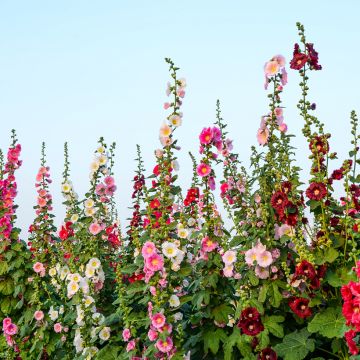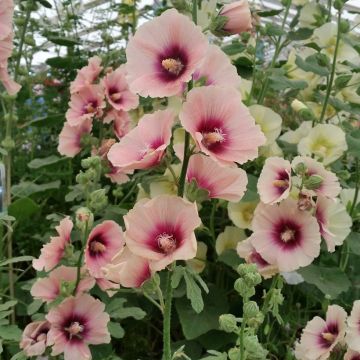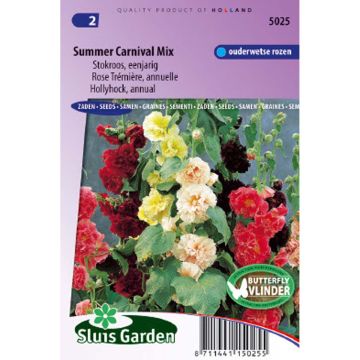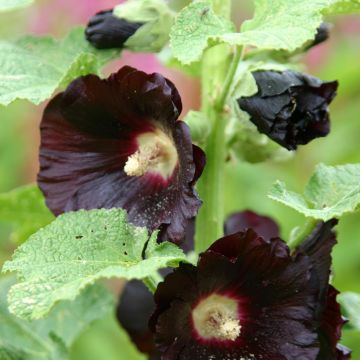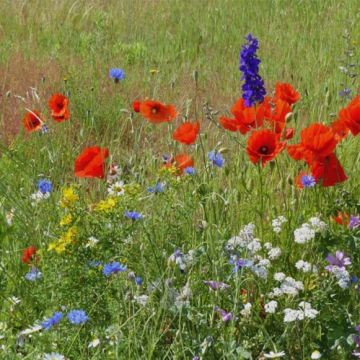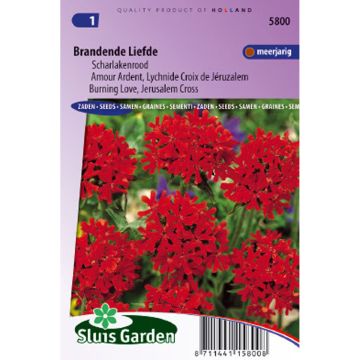

Alcea rosea Chater's Double Pink seeds - Hollyhock


Alcea rosea Chater's Double Pink seeds - Hollyhock
Alcea rosea Chater's Double Pink seeds - Hollyhock
Alcea rosea Chater's Double Rose-Pink
Hollyhock
This item cannot be shipped to the selected country
Dispatch by letter from €3.90
More information
Schedule delivery date,
and select date in basket
This plant carries a 6 months recovery warranty
More information
We guarantee the quality of our plants for a full growing cycle, and will replace at our expense any plant that fails to recover under normal climatic and planting conditions.
Seed-only orders are dispatched by sealed envelope. The delivery charge for seed-only orders is €3.90.
Does this plant fit my garden?
Set up your Plantfit profile →
Description
Alcea rosea 'Chater's Double Rose-Pink' is a tall and superb hollyhock with very double flowers displaying a fresh and vivid pink colour. Its floral stems are spectacular, but they can be broken by the wind. For this reason, it is often planted against a wall or at the back of a border, leaning against bushes for example. Grown as a biennial in a temperate climate, it self-seeds spontaneously. Essential in cottage gardens, its long romantic flowering period also attracts numerous pollinating insects.
Alcea rosea belongs to the Malvaceae family and originates from Asia Minor. This species has become an emblematic plant in European gardens. The 'Chater's Double Rose-Pink' variety is part of the famous 'Chater's' series, developed in the UK by Thomas Chater in the 19th century. The 'Chater's' cultivars are known for their large very double, pompon-shaped flowers which differ from classic hollyhocks by the density of their petals. These hollyhocks are characterised by sturdy floral stems that can reach 2 to 2.5 meters in height. They bear flowers with tight and crumpled petals, giving them a particularly voluminous and charming appearance. The flowers of 'Chater's Double Rose-Pink', around 10 cm in diameter, display a pure pink tone that catches the light. This flowering appears on plants at least two years old. It starts in June and continues until August, with the flowers gradually blooming from the bottom to the top of the stem. After flowering, the plant produces dry fruits filled with seeds that self-sow naturally, often in unexpected areas of the garden such as crevices in walls or rocky soils. The light green foliage is composed of lobed and rounded leaves gathered in a tuft at the base of the plant. It is semi-evergreen.
The 'Chater's Double Rose-Pink' hollyhock is a great classic in rustic and romantic gardens or "English-style" gardens. Its candy pink hue blends perfectly with tall pastel-flowering plants such as pink foxgloves or white foxgloves. You can also associate it with mulleins like 'Pink Domino' or blue delphiniums. The perennial Geranium 'Rozanne', with its mauve blue flowers and low habit, can create a flowery carpet at the base of the hollyhock floral stems.
Report an error about the product description
Flowering
Foliage
Plant habit
Botanical data
Alcea
rosea
Chater's Double Rose-Pink
Malvaceae
Hollyhock
Cultivar or hybrid
Other Hollyhock seeds
Planting and care
Sow Hollyhocks from May to July. It takes 15 to 20 days for the shoots to appear. Transplant the young plants, when they reach a height of 7 cm, at a distance of 20 cm from each other. The following spring, place them in your borders at a distance of 40 to 50 cm. Be prepared to stake them if the location is not sheltered from the wind. Avoid planting Hollyhocks in the same spot for several years in a row to prevent the appearance of rust (a parasitic fungus visible as orange powder) on the foliage.
Sowing period
Intended location
This item has not been reviewed yet - be the first to leave a review about it.
Flower seeds
Haven't found what you were looking for?
Hardiness is the lowest winter temperature a plant can endure without suffering serious damage or even dying. However, hardiness is affected by location (a sheltered area, such as a patio), protection (winter cover) and soil type (hardiness is improved by well-drained soil).

Photo Sharing Terms & Conditions
In order to encourage gardeners to interact and share their experiences, Promesse de fleurs offers various media enabling content to be uploaded onto its Site - in particular via the ‘Photo sharing’ module.
The User agrees to refrain from:
- Posting any content that is illegal, prejudicial, insulting, racist, inciteful to hatred, revisionist, contrary to public decency, that infringes on privacy or on the privacy rights of third parties, in particular the publicity rights of persons and goods, intellectual property rights, or the right to privacy.
- Submitting content on behalf of a third party;
- Impersonate the identity of a third party and/or publish any personal information about a third party;
In general, the User undertakes to refrain from any unethical behaviour.
All Content (in particular text, comments, files, images, photos, videos, creative works, etc.), which may be subject to property or intellectual property rights, image or other private rights, shall remain the property of the User, subject to the limited rights granted by the terms of the licence granted by Promesse de fleurs as stated below. Users are at liberty to publish or not to publish such Content on the Site, notably via the ‘Photo Sharing’ facility, and accept that this Content shall be made public and freely accessible, notably on the Internet.
Users further acknowledge, undertake to have ,and guarantee that they hold all necessary rights and permissions to publish such material on the Site, in particular with regard to the legislation in force pertaining to any privacy, property, intellectual property, image, or contractual rights, or rights of any other nature. By publishing such Content on the Site, Users acknowledge accepting full liability as publishers of the Content within the meaning of the law, and grant Promesse de fleurs, free of charge, an inclusive, worldwide licence for the said Content for the entire duration of its publication, including all reproduction, representation, up/downloading, displaying, performing, transmission, and storage rights.
Users also grant permission for their name to be linked to the Content and accept that this link may not always be made available.
By engaging in posting material, Users consent to their Content becoming automatically accessible on the Internet, in particular on other sites and/or blogs and/or web pages of the Promesse de fleurs site, including in particular social pages and the Promesse de fleurs catalogue.
Users may secure the removal of entrusted content free of charge by issuing a simple request via our contact form.
The flowering period indicated on our website applies to countries and regions located in USDA zone 8 (France, the United Kingdom, Ireland, the Netherlands, etc.)
It will vary according to where you live:
- In zones 9 to 10 (Italy, Spain, Greece, etc.), flowering will occur about 2 to 4 weeks earlier.
- In zones 6 to 7 (Germany, Poland, Slovenia, and lower mountainous regions), flowering will be delayed by 2 to 3 weeks.
- In zone 5 (Central Europe, Scandinavia), blooming will be delayed by 3 to 5 weeks.
In temperate climates, pruning of spring-flowering shrubs (forsythia, spireas, etc.) should be done just after flowering.
Pruning of summer-flowering shrubs (Indian Lilac, Perovskia, etc.) can be done in winter or spring.
In cold regions as well as with frost-sensitive plants, avoid pruning too early when severe frosts may still occur.
The planting period indicated on our website applies to countries and regions located in USDA zone 8 (France, United Kingdom, Ireland, Netherlands).
It will vary according to where you live:
- In Mediterranean zones (Marseille, Madrid, Milan, etc.), autumn and winter are the best planting periods.
- In continental zones (Strasbourg, Munich, Vienna, etc.), delay planting by 2 to 3 weeks in spring and bring it forward by 2 to 4 weeks in autumn.
- In mountainous regions (the Alps, Pyrenees, Carpathians, etc.), it is best to plant in late spring (May-June) or late summer (August-September).
The harvesting period indicated on our website applies to countries and regions in USDA zone 8 (France, England, Ireland, the Netherlands).
In colder areas (Scandinavia, Poland, Austria...) fruit and vegetable harvests are likely to be delayed by 3-4 weeks.
In warmer areas (Italy, Spain, Greece, etc.), harvesting will probably take place earlier, depending on weather conditions.
The sowing periods indicated on our website apply to countries and regions within USDA Zone 8 (France, UK, Ireland, Netherlands).
In colder areas (Scandinavia, Poland, Austria...), delay any outdoor sowing by 3-4 weeks, or sow under glass.
In warmer climes (Italy, Spain, Greece, etc.), bring outdoor sowing forward by a few weeks.


































